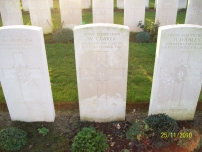| First Name: | William | Last Name: | CAWKER | |
|---|---|---|---|---|
| Date of Death: | 15/09/1916 | Lived/Born In: | Barking | |
| Rank: | Private | Unit: | Coldstream Guards2 | |
| Memorial Site: | Barking Memorial | |||
Current Information:Born-Barking Guards' Cemetery, Lesboeufs, Somme
The Battle of the Somme (July-November, 1916) By the beginning of September, 1916, the Battle of the Somme had been raging for two months. Thousands of men had already been killed or wounded or were simply missing, never to be seen again and and just a few square miles of the French countryside, all in the southern part of the battlefield, had been captured from the enemy. Mistakes had been made by the various commanders and would be continued to be made but there was no turning back as the British, Australians, South Africans, New Zealanders and Canadians carried on battering away at the German defences in the hope of a breakthrough, So it continued all the way through to November with nearly every battalion and division then in France being drawn into it at some stage. In the end the German trenches had been pushed back a few more miles along most of the line but the cost in lives had been staggering. By the end of the fighting in November, 1916, British Army casualties numbered over 400,000, killed, wounded and missing. The Battle of Flers (15-22 September, 1916) On 15th September, 1916, the offensive on the Somme was renewed with a full scale attack on the German third line of defences. Four Army Corps were used on a front that stretched from Combles, through the village of Flers and on to Courcelette.. The artillery barrage that preceded this attack was more concentrated than that on 1st July and the attack itself was more successful. The villages of Flers, Martinpuich and Courcelette were captured and the enemy was finally pushed out of High Wood, but the breakthrough was not achieved and the reality was that when the battle ended on 22nd September, the front line had just been moved forward a mile or so. The battle is notable for being the first time that tanks were used. The Guards Division were heavily involved in the attack on 15th September when 2nd Guards Brigade on the right and 1st Guards Brigade on the left attacked the village of Lesboeufs from a position in front of Ginchy. 1st Guards Brigade attacked with the 2nd Coldstream Guards and 3rd Coldstream Guards battalions in front, 1st Irish Guards in the second line and 2nd Grenadiers Guards in the rear. Only 5 of the 10 tanks allotted to the Guards Division made it to the start and these then either broke down or lost direction and had little effect. At 6.20am 1st Guards Brigade advanced behind a creeping barrage but 2nd and 3rd Coldstream Guards straight away met machine-gun fire from the junction of Pint Trench and the sunken portion of the Flers road and sustained many casualties. However after a brief check they rushed and overwhelmed the Germans here. 1st Irish Guards moved up quickly and lent their weight and all three battalions pressed on and reached the first objective about 7.15am. Unfortunately the battalion commanders mistakenly decided that they had reached the third objective and sent a pigeon back with this information, whereas really they were still 1300 yards behind it. To the right the enemy still held Serpentine Trench on both sides of its junction with Calf Alley. Once this error had been realised the two Coldstream battalions pushed on and by 11.15am they were in possession of some of their second objective where they consolidated. Among their casualties on 15th September was William Cawker of 2nd Coldstream Guards. |
||||
| « Back to Search Results | ||||
| If you think any of the information shown here is incorrect, Click Here to submit your amends and comments | ||||




